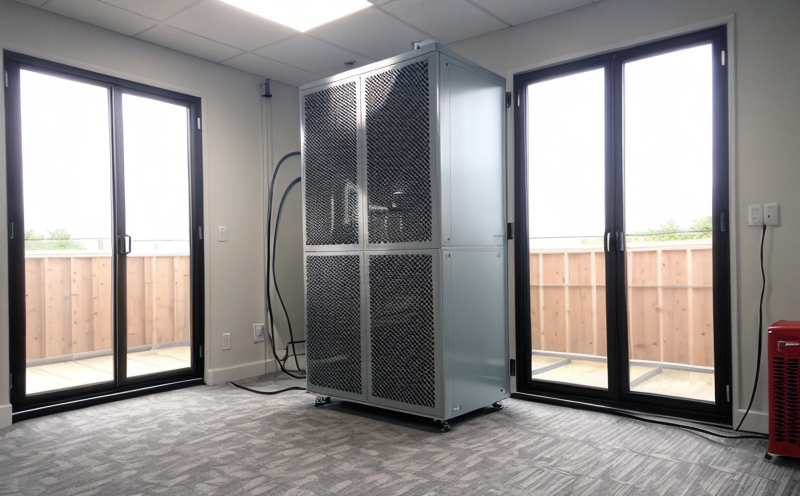ASHRAE 129 Airflow Measurement in Residential Systems
The ASHRAE Standard 129 provides methodologies for measuring airflow within residential HVAC systems. This standard is crucial for ensuring the proper performance and efficiency of HVAC equipment, as well as maintaining indoor air quality. By adhering to this protocol, manufacturers, installers, and quality assurance teams can ensure that their products meet the necessary standards before deployment.
The ASHRAE 129 method involves a series of tests designed to measure airflow in various parts of residential HVAC systems. This includes supply ducts, return ducts, and any other components where air flow is critical for system performance. The tests are performed using specific instruments that can accurately measure the volume and velocity of air passing through these systems.
The testing process typically begins with a thorough inspection of the HVAC system to identify potential areas of concern. Once identified, the appropriate instrumentation is used to make precise measurements. This may involve placing probes at key points within the system to capture data on airflow rates. The collected data is then analyzed against the criteria outlined in ASHRAE 129 to determine whether the system meets the necessary performance standards.
The importance of this testing cannot be overstated, as it directly impacts the comfort and health of occupants. Proper airflow ensures that fresh air can enter the home effectively, reducing the risk of poor indoor air quality which can lead to respiratory issues or other health problems. Additionally, by ensuring optimal airflow, HVAC systems operate more efficiently, leading to lower energy costs and extended system lifespan.
For manufacturers, this testing is essential for quality assurance purposes. It allows them to identify any discrepancies between the expected performance of their equipment and its actual performance post-installation. This information can then be used to make necessary adjustments or improvements in future product versions.
- Customer Impact: Ensures a healthier living environment with reduced risks of poor air quality.
- Efficiency Gains: Optimized airflow leads to lower energy consumption and improved system longevity.
- Health Benefits: Reduced risk of respiratory issues due to optimal ventilation.
In summary, ASHRAE 129 is a critical standard for residential HVAC systems. It provides a robust framework for ensuring that airflow within these systems meets the necessary standards, thereby enhancing both performance and occupant health.
Why It Matters
The ASHRAE 129 standard is essential in maintaining the integrity of residential HVAC systems. Proper airflow is one of the key factors that determine a system's efficiency and overall performance. Without adequate airflow, heat exchangers may not function correctly, leading to reduced heating or cooling capabilities. In extreme cases, this can result in equipment failure, which increases maintenance costs and downtime.
In addition to performance issues, improper airflow can significantly impact indoor air quality (IAQ). Poor IAQ is linked to a variety of health concerns such as allergies, asthma, and other respiratory problems. By ensuring that airflow within the system meets ASHRAE 129 guidelines, we help create healthier living environments for occupants.
From an economic standpoint, optimizing airflow can lead to significant savings in energy costs. Efficient HVAC systems operate more effectively, reducing both heating and cooling demands. This not only lowers utility bills but also extends the lifespan of the equipment, further justifying compliance with ASHRAE 129 standards.
The standard is particularly important for ensuring that new installations are correctly configured. Proper setup of the HVAC system can prevent future issues such as uneven temperature distribution or localized hotspots within a building. These problems not only degrade user experience but also reduce the overall effectiveness of the system.
In conclusion, adhering to ASHRAE 129 is more than just a compliance requirement; it's an investment in maintaining high-quality residential HVAC systems that provide both efficiency and health benefits for occupants.
Customer Impact and Satisfaction
When ASHRAE 129 is implemented correctly, customers experience several tangible benefits:
Competitive Advantage and Market Impact
Implementing ASHRAE 129 in residential HVAC systems provides several competitive advantages:
- Innovation Leadership: By staying ahead of regulatory changes and best practices, you position your company as a leader in innovation. This can attract more customers seeking cutting-edge technology.
- Customer Trust: Compliance with ASHRAE 129 builds trust among customers who value quality and reliability. This enhances brand reputation and customer loyalty.
- Differentiation from Competitors: Offering services that meet or exceed industry standards can differentiate your company from competitors, especially in a crowded market.
In the broader context of the HVAC sector, adherence to ASHRAE 129 aligns with global trends towards sustainability and energy efficiency. This can open up new markets and opportunities for businesses committed to these values. Additionally, it positions you as an industry expert capable of providing comprehensive solutions that go beyond basic installation.
In conclusion, the implementation of ASHRAE 129 in residential HVAC systems not only enhances your company's reputation but also provides a solid foundation for sustainable growth and market leadership.





